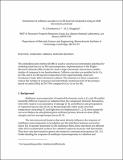Simulations of Collision Cascades in Cu–Nb Layered Composites Using an EAM Interatomic Potential
Author(s)
Demkowicz, Michael J.; Hoagland, R. G.
Downloadijam_mjd_d1.pdf (3.397Mb)
OPEN_ACCESS_POLICY
Open Access Policy
Creative Commons Attribution-Noncommercial-Share Alike
Alternative title
World Scientific
Terms of use
Metadata
Show full item recordAbstract
The embedded atom method (EAM) is used to construct an interatomic potential for modelling interfaces in Cu–Nb nanocomposites. Implementation of the Ziegler–Biersack–Littmark (ZBL) model for short-range interatomic interactions enables studies of response to ion bombardment. Collision cascades are modelled in fcc Cu, bcc Nb, and in Cu–Nb layered composites in the experimentally-observed Kurdjumov–Sachs (KS) orientation relation. The interfaces in these composites reduce the number of vacancies and interstitials created per keV of the primary knock-on atom (PKA) by 50–70% compared to fcc Cu or bcc Nb.
Date issued
2009-09Department
Massachusetts Institute of Technology. Department of Materials Science and EngineeringJournal
International Journal of Applied Mechanics
Citation
DEMKOWICZ, M. J., and R. G. HOAGLAND. “SIMULATIONS OF COLLISION CASCADES IN Cu–Nb LAYERED COMPOSITES USING AN EAM INTERATOMIC POTENTIAL.” International Journal of Applied Mechanics 01, no. 03 (September 2009): 421-442.
Version: Author's final manuscript
ISSN
1758-8251
1758-826X